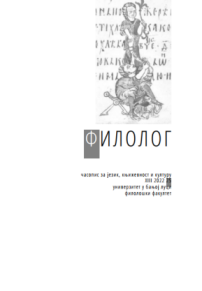TEORIJA PRAKSE I UNIVERZITETSKA CLIL NASTAVA:
PREDLOG ZADATKA NA PRIMERU GEOMITOLOGIJE
THEORY OF PRACTICE AND A BRIEF OVERVIEW OF TASK DESIGN IN UNIVERSITY CLIL TEACHING – AN EXAMPLE OF GEOMYTHOLOGY
Author(s): Lidija Beko, Dragoslava MićovićSubject(s): Language and Literature Studies, Education
Published by: Филолошки факултет Универзитета у Бањој Луци
Keywords: CLIL; theory of practice; teacher-researcher; geomitology; communicative skills;
Summary/Abstract: Challenging the established practice and canons has never been an easy task, i. e. ”a walk in the park”. This paper attempts to provide reasons for believing that the complexity of the CLIL method requires a new type of teacher focused on scientific research, recording and monitoring of their practice. Teachers-researchers, in the spirit of the new era of knowledge, especially when it comes to university teaching or transformative teaching, promote the improvement of contextual language education based on a true understanding of all kinds of academic specificities. Appropriate theory of practice, in order to be useful and applicable, must be pragmatic and tailored to the specific needs of a particular classroom. The theory of practice, intended for CLIL lecturers working in certain unexplored circumstances, is additionally demanding because it expects teachers to improve their practice and often create their own teaching materials, which are missing and which do not seem to appear on the market soon. The teacher-researcher, in that sense, should first examine, describe, evaluate and improve his practice, going into the depth of understanding the linguistic contextual situation and the complex concept of teaching such as CLIL. If teachers, as the backbone of the teaching process, do not engage in the right measure and in the right way in creating their own teaching identity, there is a possibility that they will not succeed when it comes to creating the identity of their students either. This means elucidating all the elements of small and large culture, as well as elucidating and creating new forms of communication and discursive forms that the new language practice spontaneously imposes. Introducing myth into teaching practice is an attempt to create wider possibilities of the teaching process through myth, so that myth, as a rich pedagogical resource, will be used to develop critical spirit, improve learning in the field of major studies and form patterns of tolerant and quality communicative competence. The assumption that this is an ambitious task and that it implies additional time efforts was not left out. However, the dominant intention was that the new teaching materials contribute to the creation of the student’s expertise and personality, and that each segment of the work leads to a higher level of knowledge, communicative skills and cultural understanding. The research confirmed the interest, activation and positive attitudes of students who see myths as more modern and flexible forms of teaching. Students showed a willingness to cooperate, talk, debate in an area they know very little about and in a way, they have never learned a language. Taking into account all the results we have obtained, we unequivocally conclude that the initial research needs additional, subsequent consideration, in order to obtain an even higher level of quality in teaching and language application.
Journal: Филолог – часопис за језик, књижевност и културу
- Issue Year: 13/2022
- Issue No: 25
- Page Range: 203-221
- Page Count: 19
- Language: Serbian

